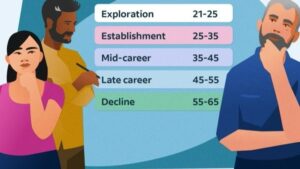Global recruitment company Indeed was forced to apologise after being taken to task over a description of career age stages (as pictured) on their website. The definition they used dates back to the 1950s – although it’s hard to imagine it was considered anything other than flawed even then, when age was more closely linked to seniority and perhaps commanded greater respect than it does now.
Creating this graphic and describing age 45+ as “late career” and 55+ as “in decline” rightly kicked up a storm after it was flagged, generating column inches and outrage. But it’s not so surprising.

Ageism is the silent ‘ism’ that permeates working life. It’s the reason why women over 50 in particular will struggle to find employment to match their skills and experience and why they have the highest gender pay gap at 20%.
To shift attitudes demands cultural change, and a re-assessment of the value that older people can offer. All the research shows that multi-generational, diverse workforces bring value to organisations by driving innovation through knowledge transfer and diverse perspectives. We need to leverage generational diversity, not dismiss people because of a number.
Related Posts
rethinking success: women, business & purpose
Can women lead the way in redefining business success? Not just as participants…
07/03/2025business,mission,entrepreneursBusiness for good,RSA,Professor SIr John Kay,Royal Society for the Arts,women in business,Purpose driven,redefining success
tackling the march of macho leadership
The march of macho leadership seems unstoppable. How can we foster genuine…
26/02/2025mission,careersElon Musk,Signalling Authenticity,dictatorships,leadership,women in leadership,Vladimir Putin,Donald Trump
why gender-inclusive product development matters
The way we design our world has long been shaped around a ‘default male’…
20/02/2025life,missionWomenInBusiness,InclusiveDesign,GenderEquity,ProductDevelopment,WomenInInnovation,WorkplaceEquality



